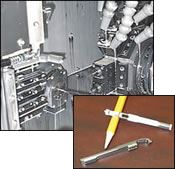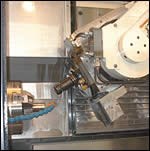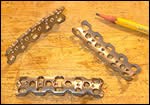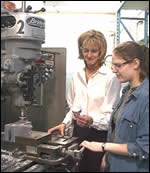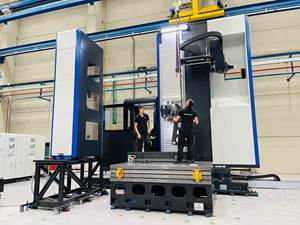Making It In Medical Machining
Examining this shop's healthy medical machining business shows that both medical components and medical customers require special care.
Share



"Can you machine natural coral?"
That's one of the more unusual questions asked recently of Tanya DiSalvo, operations manager of Criterion Tool & Die, a 22-person precision job shop in Brook Park, Ohio, near Cleveland's Hopkins Airport.
As a matter of fact, the shop doesn't machine coral—at least not for now—but it does machine titanium, Inconel, brass, aluminum, various stainless steels and a number of engineering plastics such as Vespel and Ultem. The shop machines these materials into complex components for medical implants and orthopedic instrumentation using a variety of milling and turning machines, including some eight-axis Swiss-type lathes and a turn/mill with B-axis capability.
The inquiry about the coral didn't entirely surprise Ms. DiSalvo. She not only expects such startling questions, but also welcomes them. "We want designers, developers and engineers in the medical field to come to us for novel machining solutions to medical part manufacturing."
That a researcher may be interested in natural coral confirms what Ms. DiSalvo recognizes as an important characteristic of this field. "The developers are highly creative and competitive, always racing against each other to develop more effective medical devices," she says. Ms. DiSalvo speculates that natural coral has promise as an implantable material because its substance and structure are similar to that of human bone.
About 75 to 80 percent of Criterion's contract machining business is related to medical parts and devices. The balance is mostly distributed between aerospace and electronics. Ms. DiSalvo explains: "Our niche is to provide high-precision machining services during the prototyping and design phases of product development. Our goal is to support a number of medical manufacturers with their recurring, low-volume production needs."
Difficult Parts For Dynamic Partners
According to Ms. DiSalvo, Criterion's medical machining business is shaped by two major factors: the kinds of components it manufactures and the nature of the customers it serves. The components tend to be small, complex and tightly toleranced. Workpiece materials are varied, and many are difficult to machine. The look and feel of these components is important. At the same time, Criterion's customers are looking for a partner who can help them "manage the chaos," as Ms. DiSalvo puts it. Coping with numerous design revisions and engineering changes is one part of this effort. Being ready to set up a complicated machine to make only one or two parts and then tear it down again is another.
Given that small parts with many features and tight tolerances are common in medical applications, it is no wonder that Criterion is home to a number of Swiss-type CNC automatic lathes and a turn/mill with an unusual configuration.
Criterion acquired its first Swiss-type lathe in the early 1990s. This machine proved the value of sliding headstock turning equipment for machining very small diameter parts with a number of milling operations in a single setup. Subsequently, the shop acquired two Star SV-20 Swiss-type lathes. The eight-station turret allows 48 possible combinations of drilling, cross drilling, tapping and milling. In addition, the shop recently acquired a Hitachi Seiki Super HiCell 250 six-axis turn/mill machine. This fixed headstock machine has an articulating B-axis head.
All of these machines are located in what Ms. DiSalvo calls the shop's CNC turning division. The shop has two other main divisions, one for CNC milling and one for tooling and prototyping. The shop has about 15,000 square feet devoted to manufacturing.
Although all three divisions require high levels of skill and technology, the most complex machining is performed in the turning division. The machine tools on that side are the most advanced, and the workpieces produced here are probably the most challenging as well.
Three machinists are assigned to the turning division. Each acts a programmer/operator. Because the Swiss-type and turn/mill machines are complex and difficult to program, Criterion gave the needs of these machines top priority when the shop was selecting CAM software. Criterion evaluated a number of CAM packages but settled on PartMaker Software from IMCS Inc., basing the choice on this software's ability to program its machines off-line in a productive manner (see box, below right).
Capable Machines
"A spinal plate that we are currently running on the HiCell is a good example of the sophisticated machining that today's medical components require," Ms. DiSalvo says. Samples of the part are shown in Figure 1. Made of titanium, these pieces are curved in two directions like a strip of orange peel. All of the holes in the part enter at different angles. A number of these holes are threaded. "Making these holes is where the B-axis capability of the Super HiCell has really proven its worth," Ms. DiSalvo says.
Programming this part, which is made in sizes ranging from 22 mm to 90 mm in length, would be extremely difficult to do manually, says Chuck Holian, who programs and operates this machine. "Because the part has no flat surfaces or straight edges, there's nothing to reference for orienting the tool. Approach angles have to be calculated from points projected into space," he explains. The CAM software allowed him to visualize the part geometry so it could be programmed correctly. "It wasn't just creating the tool paths for this part that was the challenge," he adds. "PartMaker created a unique postprocessor for this machine with its unusual configuration. Having an efficient postprocessor made it much easier to get this job into production."
These parts are machined from barstock and involve some complex axis moves that Ms. DiSalvo is understandably mum about. Additional contouring to complete the machining of the parts is performed on an older four-axis BostoMatic machining center that has been located nearby to form a kind of cell.
How the shop uses its Swiss-type lathes is also revealing. "Although these machines are screw machines, we've learned to look at them in new way," says Ms. DiSalvo. "Because the machines have so many options for live tooling, we look at these machines as very capable milling centers, with the sliding headstock and programmable spindle rotation acting as a very fancy parts positioner and indexer."
A good example of this thinking is a number of parts the shop produces for an instrument used in arthroscopic surgery. The parts are made from 3/8-inch barstock of 17-4PH stainless. The parts fit together to form a narrow, sliding assembly that allows the surgeon to enter the shoulder surgically and grasp the ends of suturing material so that a knot can be tied. Figure 2 shows one of the pieces in the spindle after machining but before cutoff, with a close-up of the completed parts in an inset.
"This is definitely not a round part," Ms. DiSalvo points out. "The machine uses only two turning tools—the rest is milling." She says that the sliding headstock allows most of the machining to happen within 2 mm of the spindle bushing, where overhang is minimal and the part is most rigid. For some operations, such as drilling a number of cross holes, a support bar in the gang tool post is programmed for positioning against the length of the workpiece, countering the radial forces exerted by live tools on the tool turret moving in the Z axis.
Dave Bohurjak, who programs and operates the Star Swiss-type lathes, notes that the synchronization capability of the CAM software allowed these moves to be coordinated properly. "This really lets us get the most out of the sliding headstock and numerous live tooling options."
Burrs Are No Small Matter
There's more to the story than just machining, of course. Rarely does this shop deliver parts right off the machine tool. Most components require finishing operations such as deburring and tumbling, which are done in house. Criterion also takes responsibility for outsourcing other finishing processes such as anodizing, passivation, heat treating, laser marking and electrical discharge machining.
Because "burr-free" is a condition often specified for medical components (a condition that must be carefully defined and agreed upon with customers), removing burrs gets considerable attention. Deburring operations usually involve several phases.
1. Wherever possible, deburring is incorporated in the part program. For example, a milling pass may be added to clean up an edge that is likely to produce burrs. Because the operators are also programmers, they can edit a program easily to accomplish this purpose.
2. Operators often do manual deburring between part cycles. The extent of manual deburring is usually determined by cycle times. Deburring is often combined with visual part inspection.
3. Deburring is also incorporated with finishing operations. Depending on the material and the size of possible burrs, the use of certain tumbling media and a specific type of tumbler will be sufficient to remove burrs. Other finishing operations will further round edges and smooth surfaces.
For Appearance Sake
Deburring is only one of the concerns addressed by finishing operations. The "look" of many medical components is as important as its "feel." The shop has a number of vibratory and centrifugal tumblers at its disposal. A variety of tumbling media are also available. According to Ms. DiSalvo, these finishing operations are as carefully managed as any manufacturing operation would be. Finishing procedures are detailed in shop documents and are followed scrupulously.
Scott Astor, who operates and programs one of the Swiss-type lathes, is the shop's finishing specialist. It is not unusual for him to process a part through several types of media to achieve the desired surface finish. Ceramic pieces almost the size of dog biscuits may be used to remove heavy burrs first, followed by the use of finer and finer media to polish a surface or leave a matte finish. "Consistency of results is my main goal," Mr. Astor explains. "Parts that are sent out for anodizing, for example, will come back with uneven results if we don't maintain consistent finishing operations."
Medical machining demands attention to other details. The chips produced by machining, for example, are a constant consideration. Keeping workpieces and the shop environment clean is also an issue. Because many of the materials machined at Criterion tend to produce long, stringy chips, all of the machines in the turning division are equipped with coolant boosters to raise coolant pressure to 1,000 psi. The high-pressure coolant breaks chips effectively and removes them from the cutting tool efficiently. Coolant-fed cutting tools or toolholders are used whenever practical.
All CNC machines throughout the shop are equipped with mist collectors to remove airborne particles. Air quality in the shop stays high to protect machines, exposed workpieces and shop furnishings. The environment for shop personnel benefits, as well.
A Commitment, Not A Commodity
Whereas the appeal of Criterion's turning division is the ability to do unique work on out-of-the-ordinary machine tools, its milling division attracts customers for other reasons. "Milling is a commodity," Ms. DiSalvo explains. "What has to set our milling operations apart is flexibility and efficiency. We have a wide mix of parts moving through this department, so scheduling jobs to meet recurring delivery dates while maximizing uptime is one of our key strengths."
Smaller parts are produced on a number of Kitamura MyCenter VMCs. Larger parts are produced on three Hitachi Seiki VM40II VMCs. Most of these machines are equipped with automatic pallet changers to keep non-machining time to a minimum. Fixturing and documents related to setup of each job are shelved nearby to speed change over.
Unlike the turning division, there is a clearer distinction between the duties of machine operators and those responsible for engineering setup strategies, designing fixtures and preparing programs in the milling division. Order quantities, work flow patterns and cycle times determine how operators and machines will be assigned.
In the milling department, the PartMaker CAM software contributes to flexibility in another way. Because the shop often works with designers and engineers at different stages of product development, part geometry comes through in all sorts of formats, from faxed prints to e-mailed PDF files; from electronic 2D drawing to 3D solid models. Dealing with this data expediently is essential to providing the sort of can-do, problem solving service Criterion intends to provide in its milling division. The CAM software allows Criterion to either redraw parts quickly from hard copy parts prints or to import geometry in a 2D or 3D format, regardless of which engineering system the customer used to create the part design.
Even after it is decided how the part is going to be processed and the programs are written, the company deals with changes and redesigns as they occur by updating its own design file and destroying all outdated versions referenced in job travelers.
"In some cases, our customers make changes as fast as we can make samples for them to evaluate," Ms. DiSalvo reports. "As a small machine shop, being able to take all kinds of files and use them effectively creates all kinds of opportunities. This is all part of managing the chaos," she says.
Timing Is Everything
Criterion's entry into medical machining was well timed. Medical machining has been one of the bright spots during the recent recessionary years. It has contributed the most to the company's growth during the past decade. Moreover, the future is promising. The medical industry is predicted to increase spending on manufacturing in the next few years.
Although medical machining can be a demanding, fast-paced business, Ms. DiSalvo believes that the disciplines imposed on the entire organization have made it more fit for survival. "Machining for the medical industry may be the model for the kind of manufacturing that can still thrive in this country," she says. "A shop that can make it in medical is likely to have what it takes to make it no matter what industry it serves."
Related Content
New Possibilities from Process Consolidation, Customization, AI and More at MT Technology Series East 2025
When do broadening capabilities outweigh specialization (and vice versa)? In our recap of MT Technology Series East 2025, find out how the latest generation of machines, tooling and software answers that question.
Read MoreDigitalization and Done-In-One Reign Supreme at BIEMH 2024
European manufacturers may have a different balance of markets than their U.S. counterparts, but the practical challenges they must overcome are often similar — as are the solutions.
Read MoreControlling Extreme Cutting Conditions in Large-Part Machining
Newly patented technologies for controlling chatter and vibration during milling, turning and boring operations promise to drastically reduce production time and increase machining performance.
Read MoreHow to Meet Aerospace’s Material Challenges and More at IMTS
Succeeding in aerospace manufacturing requires high-performing processes paired with high-performance machine tools. IMTS can help you find both.
Read MoreRead Next
OEM Tour Video: Lean Manufacturing for Measurement and Metrology
How can a facility that requires manual work for some long-standing parts be made more efficient? Join us as we look inside The L. S. Starrett Company’s headquarters in Athol, Massachusetts, and see how this long-established OEM is updating its processes.
Read More










